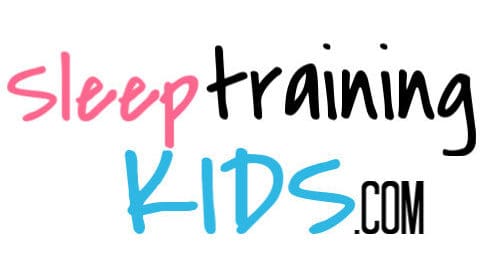When you’re overtired, it’s like every problem becomes ten times worse, thirty times harder to solve, and emotions are at least fifty times harder to control. Okay, so maybe some of those numbers aren’t quite right. But, when you’re tired, things can get a little out of control quickly, right? So how do you get an overtired baby to sleep?
In order to get an overtired baby to sleep, use good sleep hygiene, sleep-positive environments, and proactive sleep training practices to get your child’s sleep back on track. An early bedtime (for several nights) may also be your secret sauce to getting that overtired baby happy again.

How do I know if my child is overtired?
Remember how we talked about how things spiral out of control when you’re exhausted – and that’s for us adults?
It’s the same with our kids. That’s why it’s so important to help them learn to sleep – so they can process their day and learn how to handle things well. So, let’s help you get that overtired baby to sleep already! Then, after sleep training, we can all go back to our normal days of parenting cute kids.
Not sure if your child is overtired? Here’s how you can know for sure.
Look at how they’re acting. Are they:
- More cranky than normal for most of the day
- Prone to crying about everything
- Angrier than usual most of the day
- Throwing more tantrums than usual
- Screaming for no visible reason more frequently or multiple times throughout the day
If so, odds are that they’re overtired. Because while being 6 or 11 months old is rough, anger and tantrums shouldn’t be the majority of your day. Sure, they’ll happen. But when my kids were rested at this age, they were generally happy, content babies who loved to play, eat, and play some more.
So if your baby is the flaming monster version of Baby Jack-Jack who didn’t get a cookie, I’d bet they’re too tired.
Why won’t my overtired baby take a nap?
Fun fact: sleep begets sleep. So if your baby is getting enough sleep, they’re more willing to take naps and go to bed at night.
On the flip side, babies who are over-tired, over-exhausted, or just aren’t getting enough sleep, they’re going to fight naps and bedtime.
It’s a vicious cycle. And if your child is anything like mine, they’ll fight their way right through nap time and suddenly it’s bedtime. And we’re all exhausted.
So my recommendation is to focus on bedtime, first. Oh – and make sure you use a boring, sleep-inducing bedtime routine. And for a few days, use an earlier bedtime to jumpstart positive changes. You can read our article about why they’re the secret sauce to solving sleep problems here.
Once you get the nights figured out, then we can focus on naps.
My children never fit into the traditional nap schedules. It was like trying to cram square little pegs into circular holes. Instead, I had to learn to spot my children’s sleep cues – and start nap times based on those.
What’s the difference between normal sleep cues and overtired sleep signs?
What are some sleep cues? Well, there are two levels of them. There are the early sleep cues – and the “too late!” sleep cues. Here are some of my children’s early sleep cues:
- Becoming more cuddly
- Playing more quietly
- Occasional eye rub
Here are some of their “too late!” sleep cues:
- Eye rubbing
- Tired eyes
- Crying
- Screaming
- Tantrums
If I initiated a nap right when I noticed the early sleep cues, naps actually happened.
On the other hand, if I waited too long (or missed the early signs of sleepiness), then naps were awful – and that’s if they took. More often than not, the late signs meant no naps for my children. And the only way to fix the sudden, no-nap sleep deficit is with an early bedtime.
How to get an overtired baby to sleep: focus on bedtimes first
Some sleep books I’ve read have said that you have to focus on the naps first – and then the bedtime will happen naturally. That never worked for our kids. So, if your kids’ naps aren’t working, don’t stress too much. Maybe your overtired kids are more like mine.
Instead, focus on bedtimes. Make them early. Make it a part of your sleep training plan.
How early?
Our kids sometimes go to bed as early as 5:30 PM. Their usual bedtime is 6:30, though. You’ll need to do some experimenting to find the sleep schedule that’s right for your family.
While we were focusing on that bedtime, though, it was usually 6 PM. We’d eat dinner, begin calming things down, start our bedtime routine, and then say goodnight.
Focusing on bedtime first helps your child ease into the night – when they should be getting the longest, most restorative part of their sleep. In other words, it’ll cut back on the intensity of the crankiness. And, because your child isn’t as cranky (or overtired), naps become easier, longer, and more restful, too.

Be consistent and patient – and it’ll take
Now, this is the part where those sleep books and gurus assure you this will take overnight. Um, reality checks: it won’t.
It can take as long as several weeks (if not longer) of regular, consistent effort to make this work. That being said, you should start to see progress quickly.
Why the time range? Because, it’s going to take you some regular time, effort, and close observation to figure out your child’s “early” and “too late!” sleep signs.
That may take a few days – or if your kids are so overtired (like mine were!), it could take weeks.
But once you know the cues and signs that are specific to your child, then you can start timing naps and bedtime based on the earlier sleep cues.
Or until then, try the 15-minute earlier bedtimes. That little bit of time should be enough to start getting you on the right track.
And then you can focus on the naps, too. Then, you’ll finally start seeing a difference – and watch your 11-month-old child turn into a much happier, well-rested, and better version of their cute little selves.
It’s a lot of hard work – but it’s worth it, it’s doable, and you’ve got this.
